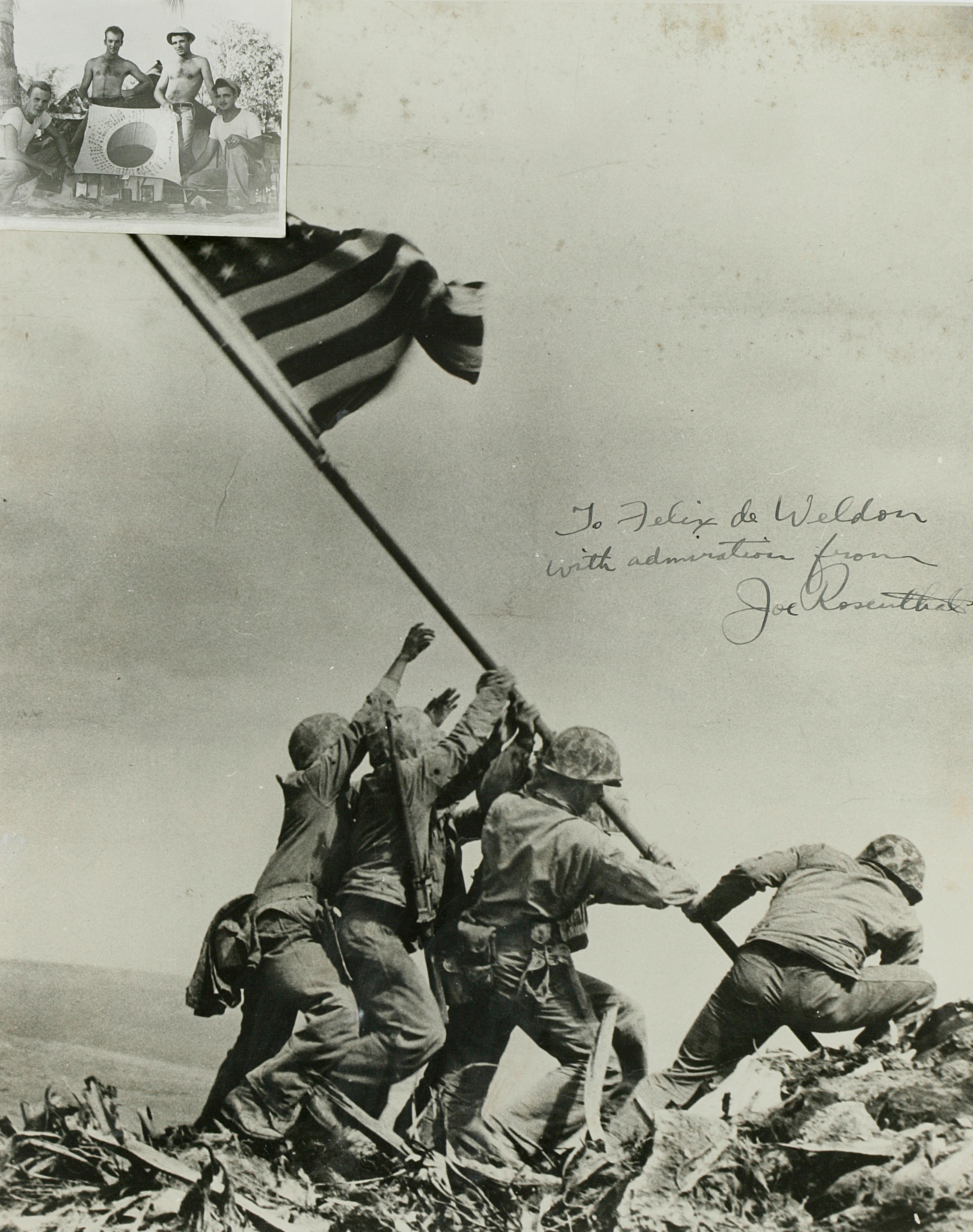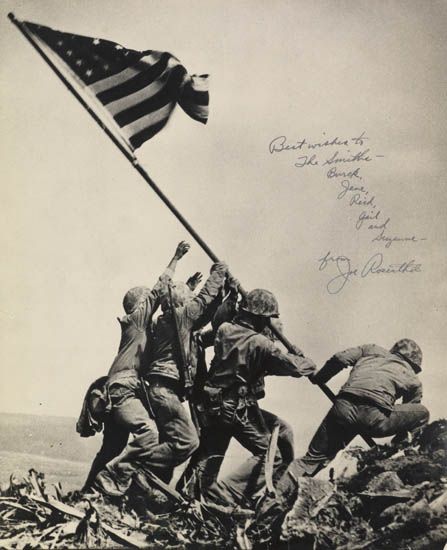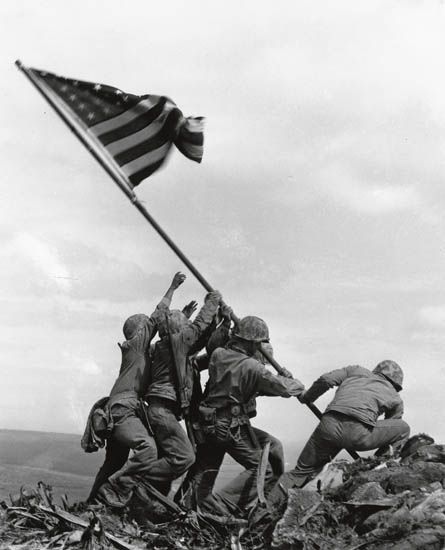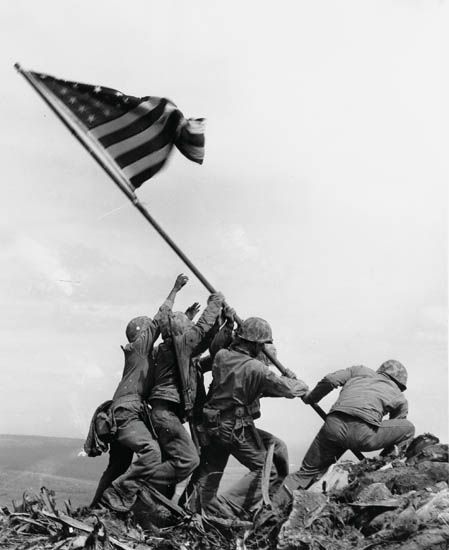"The Raising of the Flag at Iwo Jima," original transmission print on ferrotyped paper, 273 x 355 mm , AP transmission date, February 24th, 1945, sent by wirephoto from Navy Guam AP to the AP desk in San Francisco, with AP text down one side, "(FX9 (9th photo of the day)-FEB 24) Marines Hoist Flag Atop Suribachi— United States Marines of the 28th Regiment, fifth division, hoist American Flag atop Suribachi, Iwo Jima volcano, after battling Japs to top the crater," inscribed (later) in silver ink by Rosenthal, at upper right: "To Rich, who got this first. Joe Rosenthal A.P.," some light tears to margins, mounted in display case. ORIGINAL TRANSMISSION PRINT OF THIS ICONIC PHOTOGRAPH, sent through the Associated Press wire service from Guam to San Francisco, the day after the shot had been taken. The full caption on the image continues, "Photo by AP photographer Joe Rosenthal on assignment with Wartime Still Picture Pool radioed by Navy from Guam to San Francisco today. (AP Wirephoto) (NRW71315jjr/pl) 1945." The image of the "Raising of the Flag at Iwo Jima" has become one of the most iconic of World War II, captured on stamps and the subject of numerous models and commemorative works. Used by De Weldon, the sculptor, to build his two Marine monuments in Washington, as well as others around the world, it has even toured around the States with the 7th Loan drive in May and June 1945 as a large size light-weight model. This almost accidental photograph was taken by Joe Rosenthal who had scrambled up Mount Suribachi after the U.S. Marines had taken the mountain on the third day of the battle for the island. He arrived too late for the first flag raising, and was standing around at the summit, when he suddenly realized that they were replacing the first flag with a larger version (as ordered by the Admiral out at sea with the invasion force), and he literally spun around and took this shot. He sent off all his reels of film to Guam a few hours later, and this shot was selected by Guam AP to be sent back to the States. It was sent out on the news wire, creating an image that became the front page news story in almost every newspaper in the country. More importantly, it came to inspire hope for the people of America that victory in the war of the Pacific would come soon.
"The Raising of the Flag at Iwo Jima," original transmission print on ferrotyped paper, 273 x 355 mm , AP transmission date, February 24th, 1945, sent by wirephoto from Navy Guam AP to the AP desk in San Francisco, with AP text down one side, "(FX9 (9th photo of the day)-FEB 24) Marines Hoist Flag Atop Suribachi— United States Marines of the 28th Regiment, fifth division, hoist American Flag atop Suribachi, Iwo Jima volcano, after battling Japs to top the crater," inscribed (later) in silver ink by Rosenthal, at upper right: "To Rich, who got this first. Joe Rosenthal A.P.," some light tears to margins, mounted in display case. ORIGINAL TRANSMISSION PRINT OF THIS ICONIC PHOTOGRAPH, sent through the Associated Press wire service from Guam to San Francisco, the day after the shot had been taken. The full caption on the image continues, "Photo by AP photographer Joe Rosenthal on assignment with Wartime Still Picture Pool radioed by Navy from Guam to San Francisco today. (AP Wirephoto) (NRW71315jjr/pl) 1945." The image of the "Raising of the Flag at Iwo Jima" has become one of the most iconic of World War II, captured on stamps and the subject of numerous models and commemorative works. Used by De Weldon, the sculptor, to build his two Marine monuments in Washington, as well as others around the world, it has even toured around the States with the 7th Loan drive in May and June 1945 as a large size light-weight model. This almost accidental photograph was taken by Joe Rosenthal who had scrambled up Mount Suribachi after the U.S. Marines had taken the mountain on the third day of the battle for the island. He arrived too late for the first flag raising, and was standing around at the summit, when he suddenly realized that they were replacing the first flag with a larger version (as ordered by the Admiral out at sea with the invasion force), and he literally spun around and took this shot. He sent off all his reels of film to Guam a few hours later, and this shot was selected by Guam AP to be sent back to the States. It was sent out on the news wire, creating an image that became the front page news story in almost every newspaper in the country. More importantly, it came to inspire hope for the people of America that victory in the war of the Pacific would come soon.














Testen Sie LotSearch und seine Premium-Features 7 Tage - ohne Kosten!
Lassen Sie sich automatisch über neue Objekte in kommenden Auktionen benachrichtigen.
Suchauftrag anlegen